VP9 Bitstream superframe and
uncompressed header
DRAFT
Rev 1.0, 2015.12.08
1. Introduction
1.1 Frames, Tiles and Blocks
1.2 Overview of Compressed Frame Format
2. Method of specifying syntax in tabular form
3. Superframe
3.1 Syntax
3.2 Semantics
4. Uncompressed Header
4.1 Syntax
4.2 Semantics
4.3 Bit depth, Color space and chroma subsampling
4.3.1 Syntax
4.3.2 Semantics
4.4 Frame Buffers
4.5 Frame Size
4.5.1 Syntax
4.5.2 Semantics
4.6 Interpolation Filters
4.6.1 Syntax
4.6.2 Semantics
4.7 Loop Filter
4.7.1 Syntax
4.7.2 Semantics
4.8 Quantization
4.8.1 Syntax
4.8.2 Semantics
4.9 Segmentation
4.9.1 Syntax
4.9.2 Semantics
4.10 Tiles
4.10.1 Syntax
4.10.2 Semantics
Appendix A dc_qlookup and ac_qlookup tables
�
1. Introduction
This document is a description of part of the VP9 bitstream format. It covers the highlevel
format of frames, superframes, as well as the full format of the frame uncompressed header and
superframe index.
1.1 Frames, Tiles and Blocks
VP9 is based on decomposition of video image frames into rectangular pixel blocks of different
sizes, prediction of such blocks using previously reconstructed blocks, and transform coding of
the residual signal.
There are only two frame types in VP9. Intra frames or key frames are decoded without
reference to any other frame in a sequence. Inter frames are encoded with reference to
previously encoded frames or reference buffers.
Video image blocks are grouped in tiles. Based on the layout of the tiles within image frames,
tiles can be categorized into column tiles and row tiles. Column tiles are partitioned from image
frames vertically into columns and row tiles are partitioned from image frames horizontally into
rows. Column tiles are independently coded and decodable units of the video frame. Each
column tile can be decoded completely independently. Row tiles are interdependent. There has
to be at least one tile per frame. Tiles are then broken into 64x64 super blocks that are coded in
raster order within the video frame.
1.2 Overview of Compressed Frame Format
Every frame begins with an uncompressed header, followed by a compressed header. Beside
the headers, the main body of a compressed video frame contains the compressed perblock
data for one or more tiles.
Uncompressed header contains bitstream profile, frame type (intra or inter), colorspace
descriptor, YUV chroma subsampling, YUV range, frame size, motion compensation
interpolation filter type, frame buffers to be refreshed, loop filter parameters, quantization
Copyright © 2015 Google
Page 1
�
parameters, segmentation and tiling information. There is also frame context information and
binary flags indicating the use of error resilient mode, parallel decoding mode, high precision
motion vector mode, and intra only mode. See section 4 for details.
Compressed header contains frame transform mode, probabilities to decode transform size for
each block within the frame, probabilities to decode transform coefficients, probabilities to
decode modes and motion vectors, and so on.
VP9 supports consolidating multiple compressed video frames into one single chunk, called
“superframe”. The superframe index is stored in the last up to 34 bytes of a chunk. The
enclosed frames can be located by parsing superframe index. See section 3 for details.
2. Method of specifying syntax in tabular form
The syntax tables specify a superset of the syntax of all allowed bitstreams. Additional
constraints on the syntax may be specified, either directly or indirectly, in other clauses. Note
that the methods for identifying and handling errors and other such situations are not specified
in this document.
The functions presented here are used in the syntactical description. These functions are
expressed in terms of the value of a bitstream pointer that indicates the position of the next bit to
be read by the decoding process from the bitstream.
read_bits(n) reads the next n bits from the bitstream and advances the bitstream pointer
by n bit positions. When n is equal to 0, read_bits(n) is specified to return a value equal
to 0 and to not advance the bitstream pointer.
The following descriptors specify the parsing process of each syntax element:
f(n): fixedpattern bit string using n bits written (from left to right) with the left bit first. The
parsing process for this descriptor is specified by the return value of the function
read_bits(n).
u(n): unsigned integer using n bits. When n is "v" in the syntax table, the number of bits
varies in a manner dependent on the value of other syntax elements. The parsing
process for this descriptor is specified by the return value of the function read_bits(n)
interpreted as a binary representation of an unsigned integer with most significant bit
written first.
Copyright © 2015 Google
Page 2
�
s(n): signed integer using n bits for the value and 1 bit for signness. When n is "v" in the
syntax table, the number of bits varies in a manner dependent on the value of other
syntax elements. The parsing process for this descriptor is specified below:
s(n) {
value
return sign ? value : value
}
Descriptor
u(n)
u(1)
u_bytes(n): unsigned integer using n bytes with least significant byte first. When n is "v"
in the syntax table, the number of bits varies in a manner dependent on the value of
other syntax elements. The parsing process for this descriptor is specified below:
u_bytes(n) {
value = 0
for (i = 0; i < n; ++i)
value |= byte << (i * 8)
return value
}
Descriptor
u(8)
3. Superframe
Superframe is a way that vp9 uses to consolidate multiple compressed video frames into one
single chunk. The superframe index is stored in the last up to 34 bytes of a chunk. To
determine whether a chunk of data has a superframe index, check the last byte in the chunk for
the marker 3 bits (0b110xxxxx):
If the marker bits are set apply a mask to the byte:
mask 2 bits (0bxxx11xxx) and add 1 to get the size in bytes for each frame size (14)
mask 3 bits (0bxxxxx111) add add 1 to get the # of frame sizes encoded in the index (18)
Calculate the total size of the index as follows:
2 + number of frame sizes encoded * number of bytes to hold each frame size
2 represents the one byte holding a marker byte that's duplicated at the start of the index and at
Copyright © 2015 Google
Page 3
�
the end of the index.
Go to the first byte of the superframe index, and check that it matches the last byte of the
superframe index.
No valid frame can have 0b110xxxxx in the last byte. In the encoder we insure this by adding a
byte 0 to the data in this case.
The actual frames are concatenated one frame after each other consecutively. To find the
second piece of compressed data in a chunk, read the index to get the frame size, and offset
from the start of data to that byte using the size pulled from the data.
3.1 Syntax
superframe_index() {
SUPERFRAME_MARKER /* equal to 0b110 */
frame_size_length_minus_one
num_frames_minus_one
for (i = 0; i <= num_frames_minus_one; ++i)
frame_sizes[i]
SUPERFRAME_MARKER /* equal to 0b110 */
frame_size_length_minus_one
num_frames_minus_one
}
Descriptor
f(3)
u(2)
u(3)
u_bytes(v)
f(3)
u(2)
u(3)
3.2 Semantics
frame_size_length_minus_one plus one specifies the size in bytes for each frame.
num_frames_minus_one plus one specifies number of frames contained in this superframe.
frame_sizes[i] specifies the size of ith frame. Every frame_sizes[i] has
frame_size_length_minus_one + 1 bytes.
Copyright © 2015 Google
Page 4
�
4. Uncompressed Header
Uncompressed header contains bitstream profile, frame type (intra or inter), colorspace
descriptor, YUV chroma subsampling, YUV range, frame size, motion compensation
interpolation filter type, frame buffers to be refreshed, loop filter parameters, quantization
parameters, segmentation and tiling information. There is also frame context information and
binary flags indicating the use of error resilient mode, parallel decoding mode, high precision
motion vector mode, and intra only mode.
4.1 Syntax
uncompressed_header() {
FRAME_MARKER /* equal to 0b10 */
version
high
profile = (high << 1) + version
if (profile == 3)
RESERVED_ZERO /* equal to 0 */
show_existing_frame
if (show_existing_frame) {
index_of_frame_to_show
return
}
frame_type
show_frame
error_resilient_mode
if (frame_type == KEY_FRAME /* 0 */) {
SYNC_CODE /* equal to 0x498342 */
bitdepth_colorspace_sampling(profile)
refresh_frame_flags = 0xFF
Copyright © 2015 Google
Descriptor
f(2)
u(1)
u(1)
f(1)
u(1)
u(3)
u(1)
u(1)
u(1)
u(24)
Page 5
�
frame_size()
} else {
if (!show_frame)
intra_only
else
intra_only = false
if (!error_resilent_mode)
reset_frame_context
else
reset_frame_context = 0
if (intra_only) {
SYNC_CODE /* equal to 0x498342 */
if (profile > 0)
bitdepth_colorspace_sampling(profile)
refresh_frame_flags
frame_size()
} else {
refresh_frame_flags
for (i = 0; i < REFS_PER_FRAME; ++i) {
frame_refs[i]
ref_frame_sign_biases[i]
}
frame_size_from_refs()
high_precision_mv
interp_filter()
}
}
u(1)
u(2)
u(24)
u(REF_FRAMES = 8)
u(REF_FRAMES = 8)
u(3)
u(1)
u(1)
Copyright © 2015 Google
Page 6
�
if (!error_resilient_mode) {
refresh_frame_context
frame_parallel_decoding_mode
} else {
refresh_frame_context = 0
frame_parallel_decoding_mode = 1
}
frame_context_index
loop_filter()
quantization()
segmentation()
tiles(width)
compressed_header_size_in_bytes
}
u(1)
u(1)
u(2)
u(16)
4.2 Semantics
profile VP9 supports four profiles:
Profile Bit Depth SRGB Colorspace Support Chroma Subsampling
0
1
No
Yes
8
8
2
3
10 or 12
10 or 12
No
Yes
YUV 4:2:0
YUV 4:2:2, YUV 4:4:0 or YUV
4:4:41
YUV 4:2:0
YUV 4:2:2, YUV 4:4:0 or YUV
4:4:41
1If colorspace is SRGB, then Chroma subsampling is YUV 4:4:4.
show_existing_frame if set to 1, indicates the frame indexed by index_of_frame_to_show is to
be displayed, otherwise proceeds for further processing.
Copyright © 2015 Google
Page 7
�
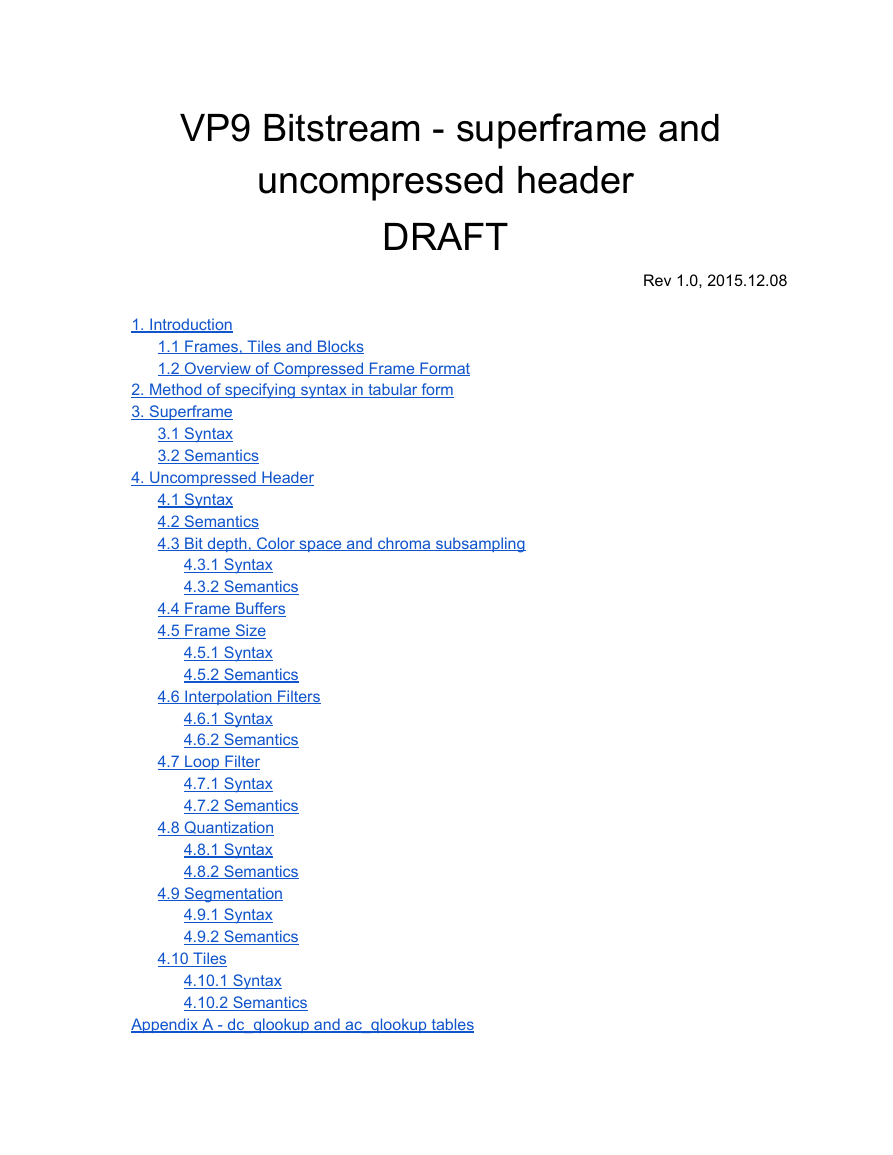

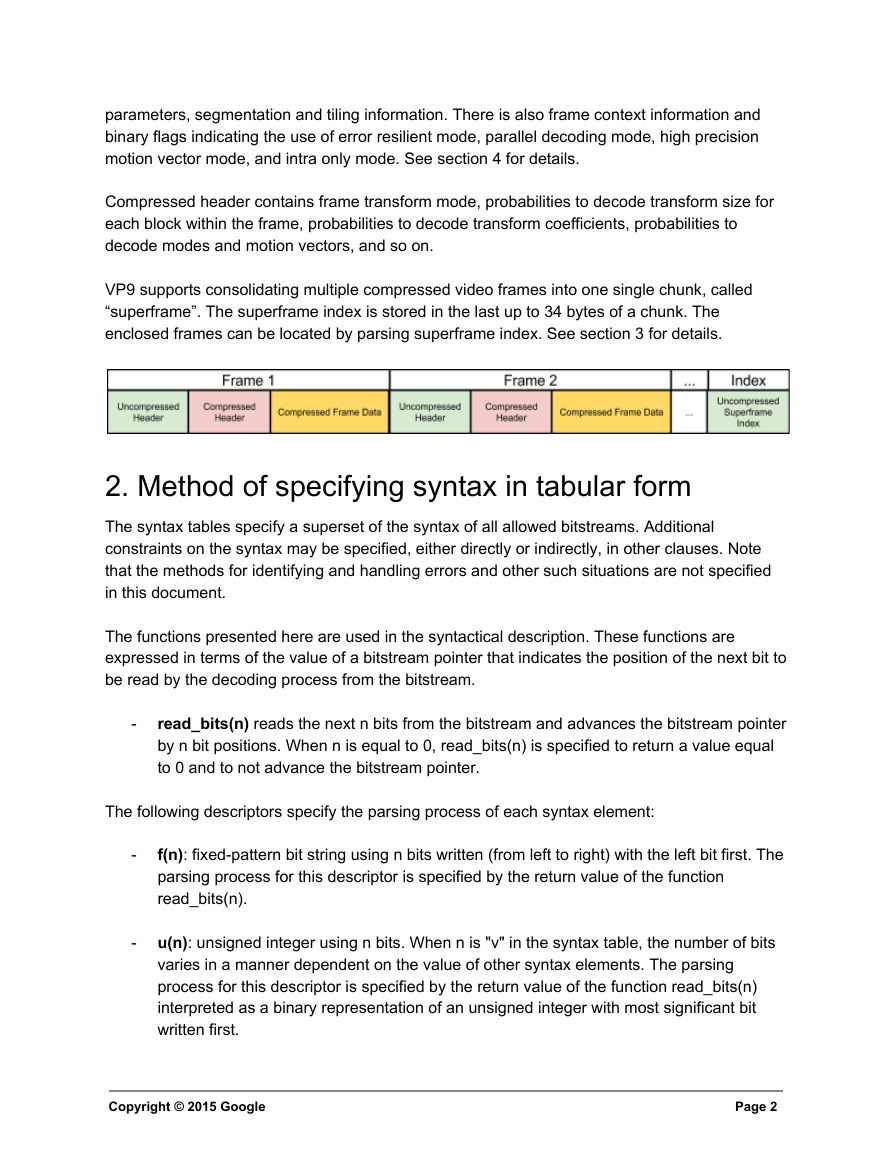
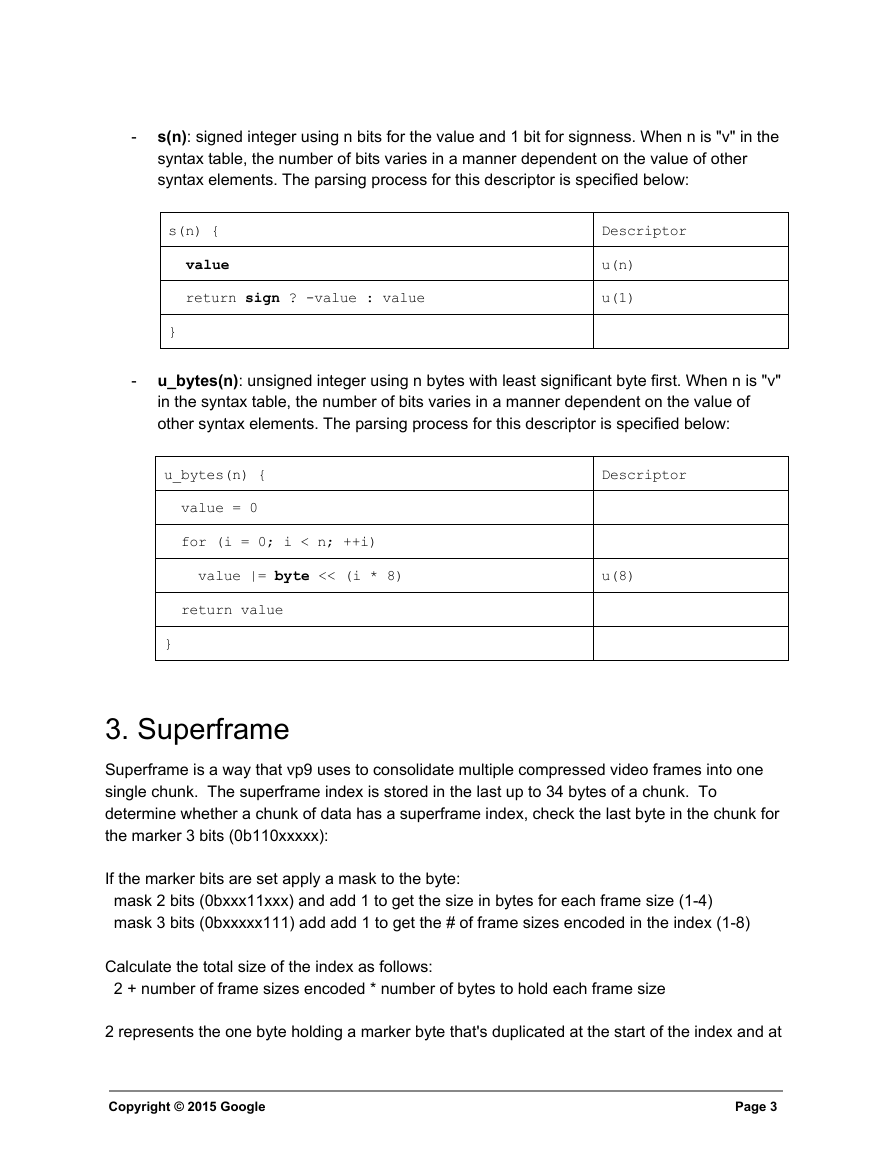
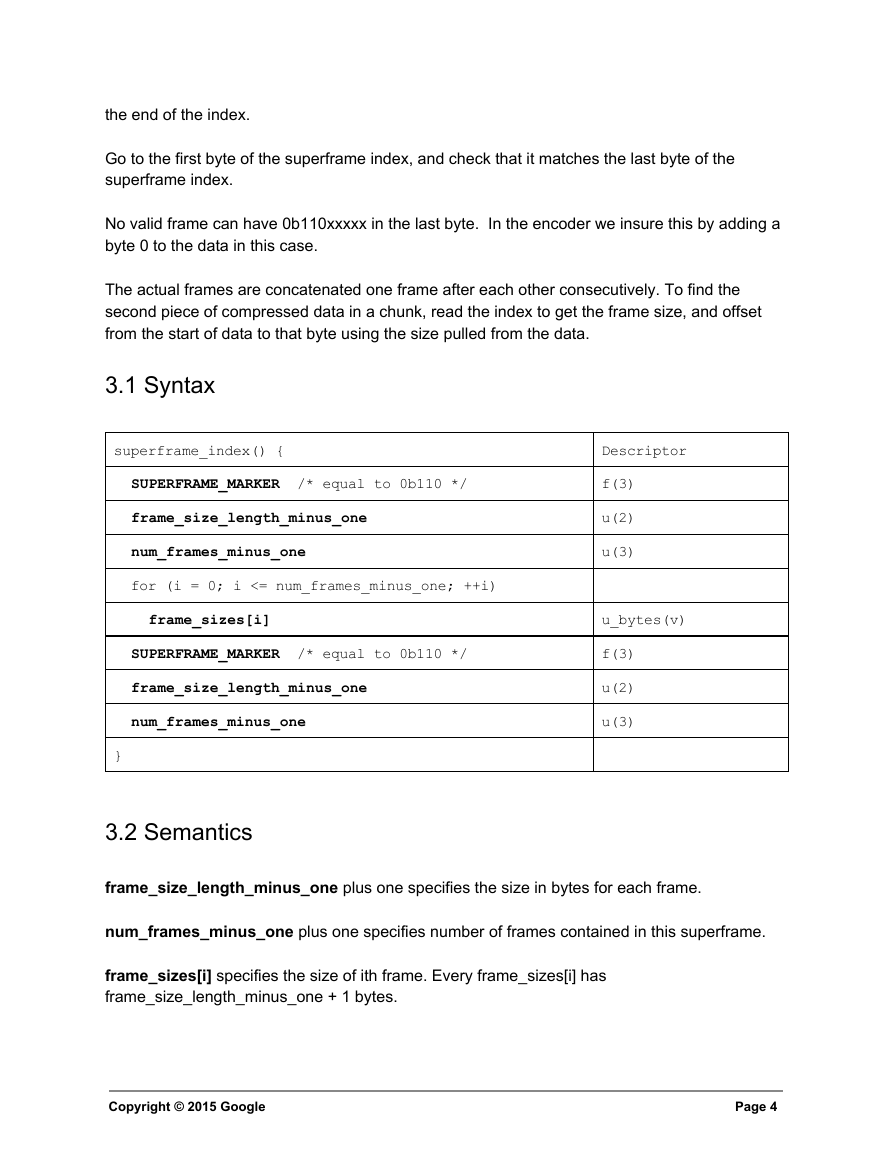
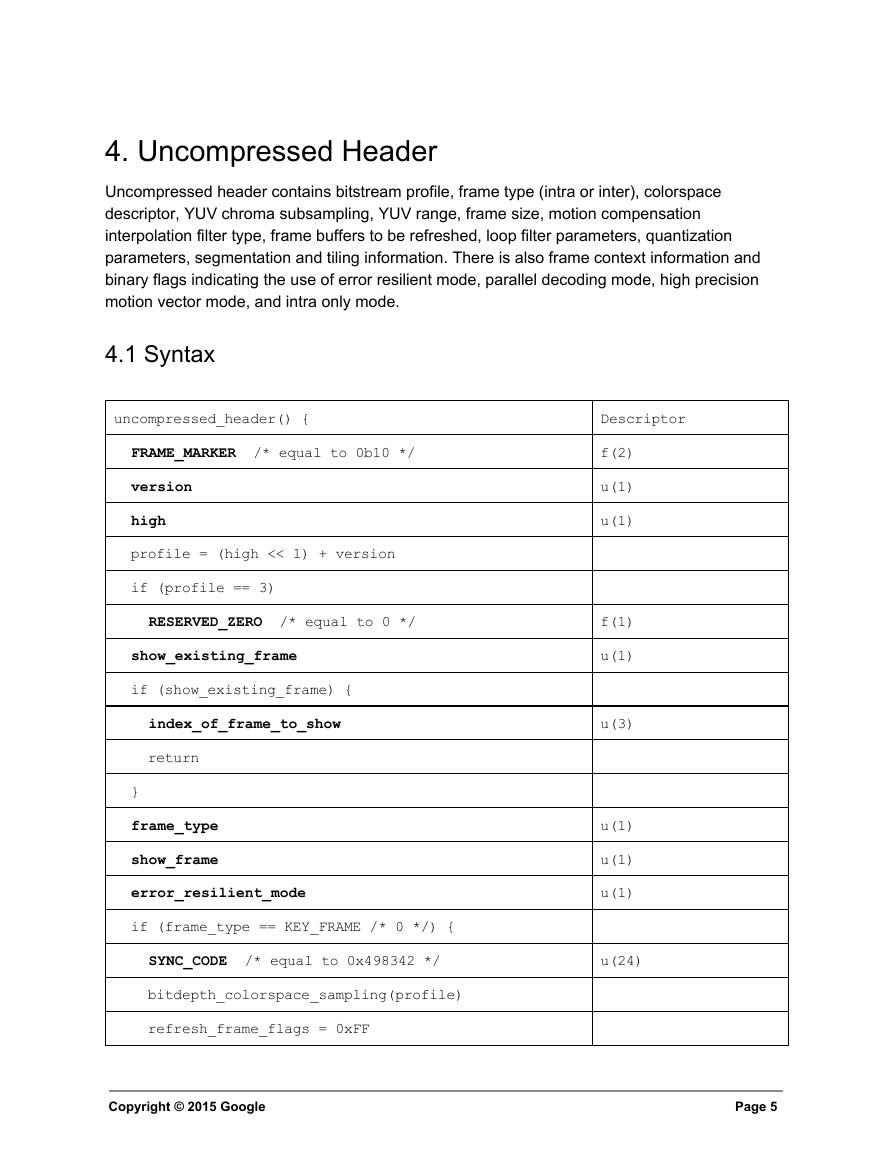
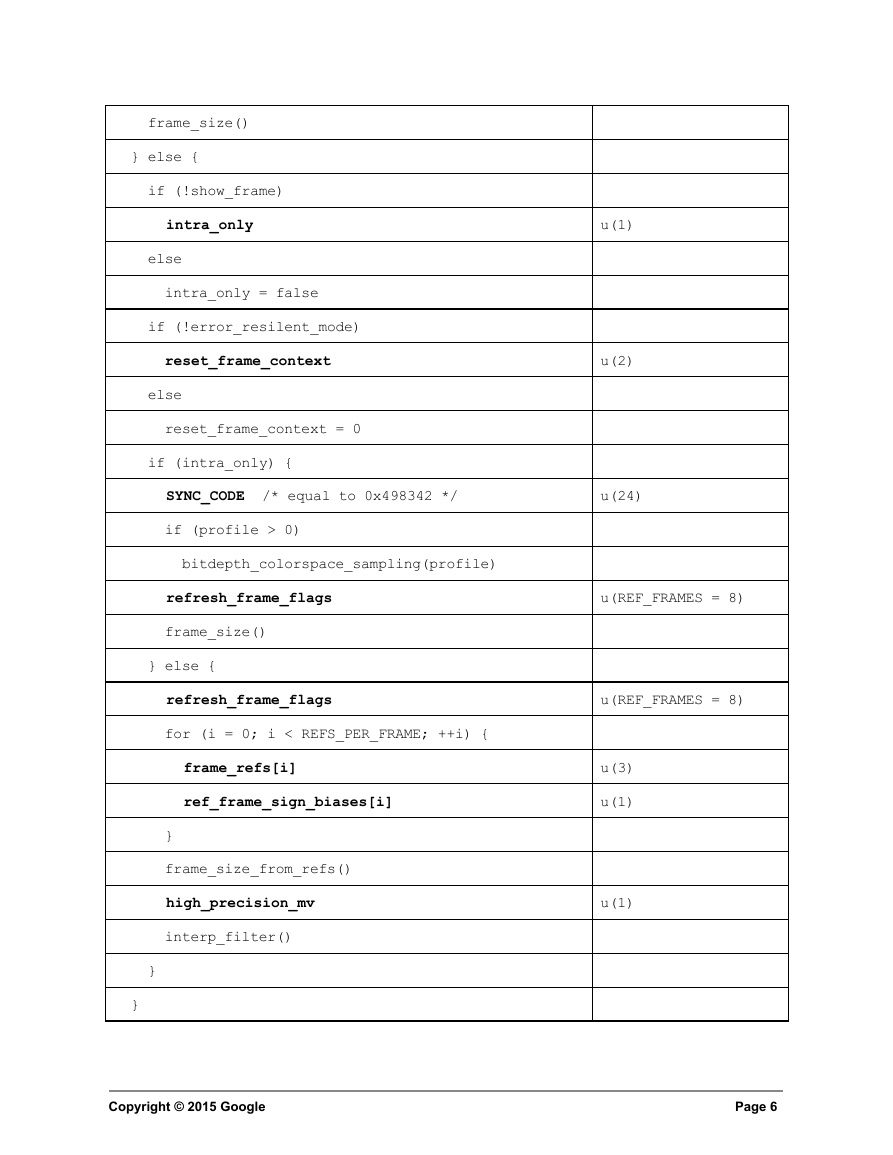
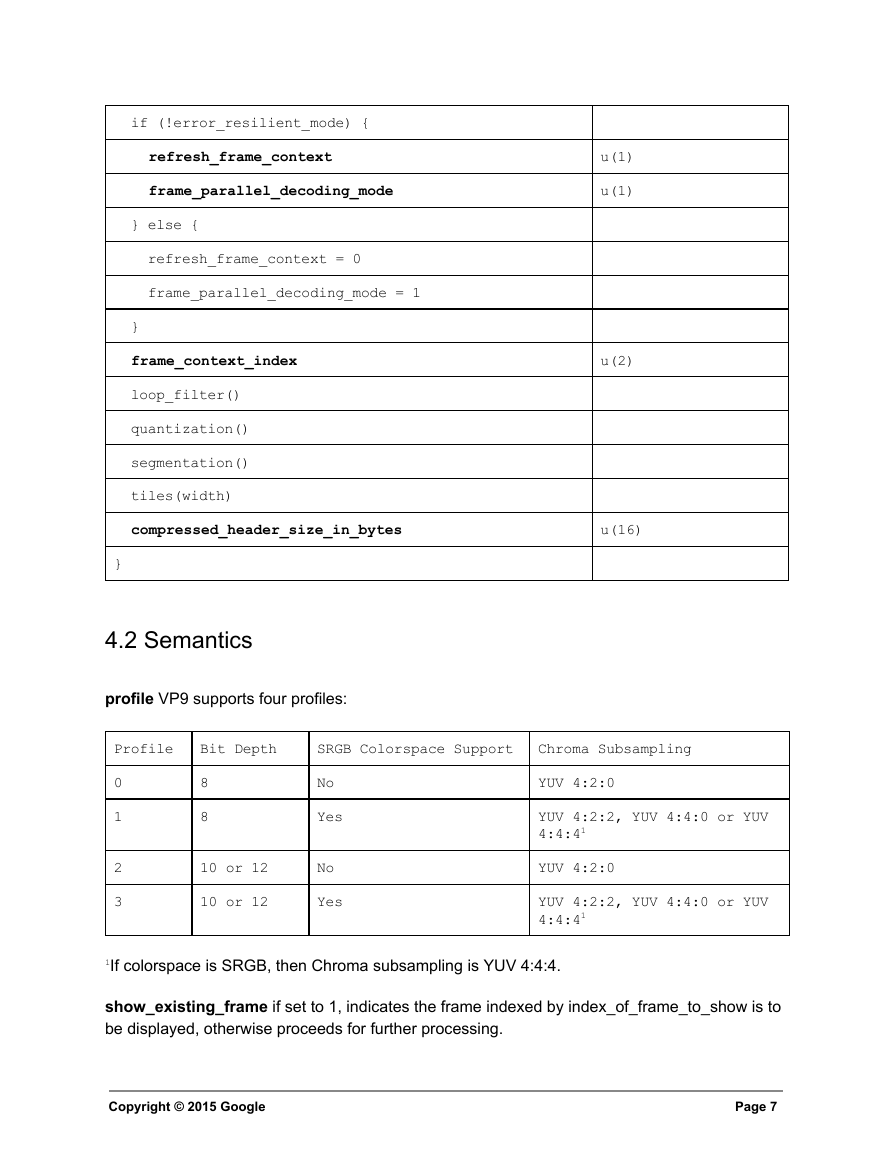








 2023年江西萍乡中考道德与法治真题及答案.doc
2023年江西萍乡中考道德与法治真题及答案.doc 2012年重庆南川中考生物真题及答案.doc
2012年重庆南川中考生物真题及答案.doc 2013年江西师范大学地理学综合及文艺理论基础考研真题.doc
2013年江西师范大学地理学综合及文艺理论基础考研真题.doc 2020年四川甘孜小升初语文真题及答案I卷.doc
2020年四川甘孜小升初语文真题及答案I卷.doc 2020年注册岩土工程师专业基础考试真题及答案.doc
2020年注册岩土工程师专业基础考试真题及答案.doc 2023-2024学年福建省厦门市九年级上学期数学月考试题及答案.doc
2023-2024学年福建省厦门市九年级上学期数学月考试题及答案.doc 2021-2022学年辽宁省沈阳市大东区九年级上学期语文期末试题及答案.doc
2021-2022学年辽宁省沈阳市大东区九年级上学期语文期末试题及答案.doc 2022-2023学年北京东城区初三第一学期物理期末试卷及答案.doc
2022-2023学年北京东城区初三第一学期物理期末试卷及答案.doc 2018上半年江西教师资格初中地理学科知识与教学能力真题及答案.doc
2018上半年江西教师资格初中地理学科知识与教学能力真题及答案.doc 2012年河北国家公务员申论考试真题及答案-省级.doc
2012年河北国家公务员申论考试真题及答案-省级.doc 2020-2021学年江苏省扬州市江都区邵樊片九年级上学期数学第一次质量检测试题及答案.doc
2020-2021学年江苏省扬州市江都区邵樊片九年级上学期数学第一次质量检测试题及答案.doc 2022下半年黑龙江教师资格证中学综合素质真题及答案.doc
2022下半年黑龙江教师资格证中学综合素质真题及答案.doc